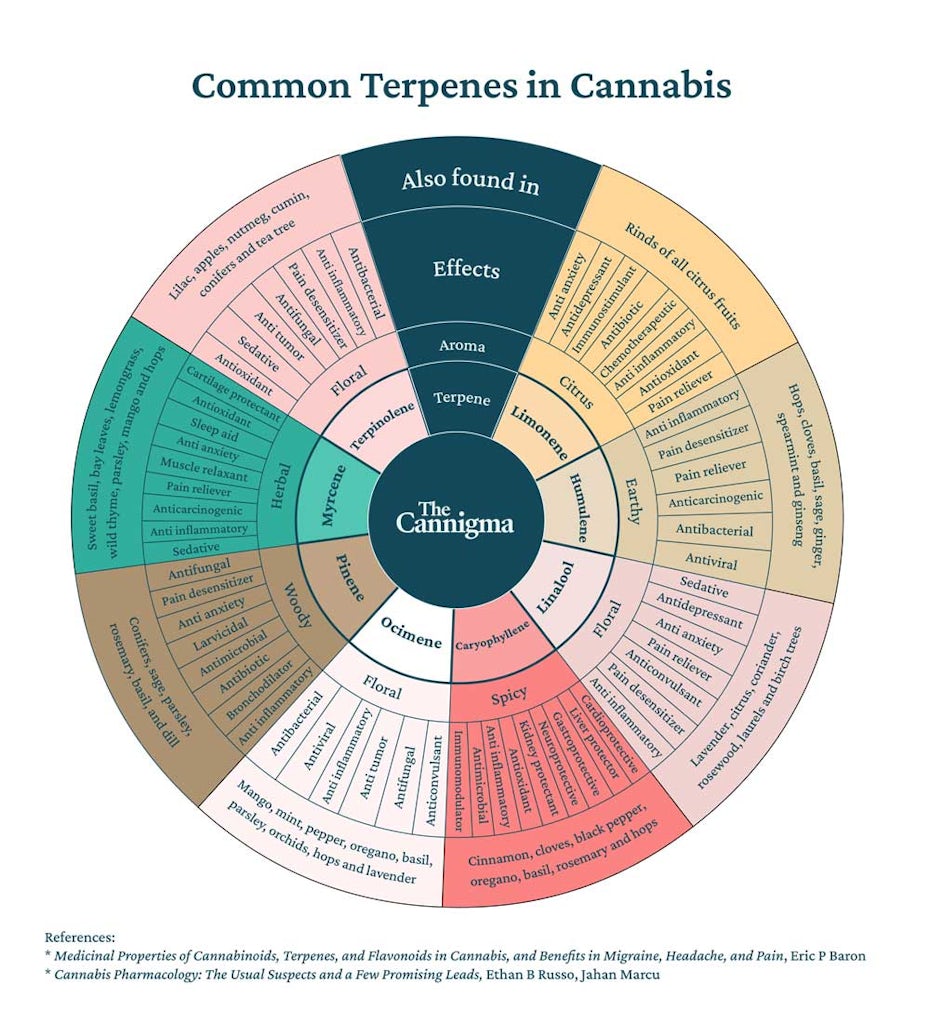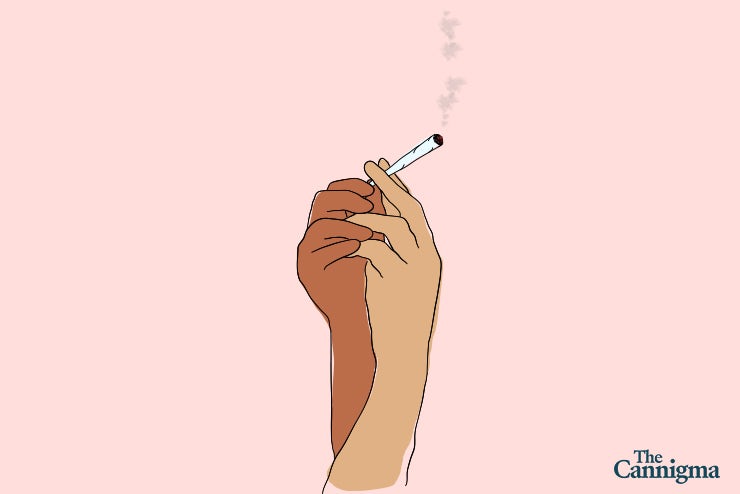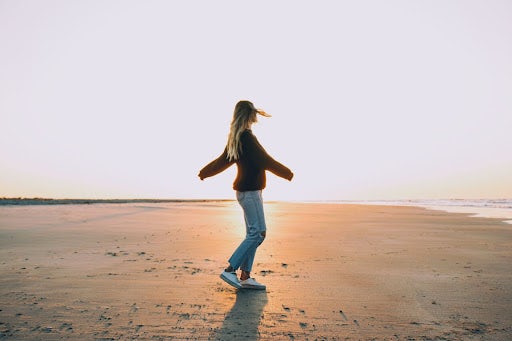The great outdoors. The sun shining high, a breeze blowing through, and somewhere in the distance a bird calls. What could be better than this?
Well, what about high hiking?
You already know that cannabis consumers are usually more active than their non-consuming counterparts and that they tend to enjoy working out more. So it makes perfect sense that people who enjoy cannabis and hiking would enjoy high hiking. Even if you’re not a hiker, consuming cannabis can make your time outside more relaxing, enjoyable, and rejuvenating.
The best strains for being outside are Type I or Type II cannabis, depending on your THC preference, with a terpene profile that includes pinene, limonene, and terpinolene.
Although strain names are unreliable, there are strains included in this article for your convenience. Aim to find strains with similar chemical profiles, not just ones that match these names.
The health benefits of getting outside
Humans have a codependent relationship with nature. Not just for food and resources to build shelters, but at the very core of our well-being. Simply put, being outside is good for your health.
Your mental, physical, and emotional health improves when you spend time outside, particularly in the sunshine. Nature gives us clean air, fresh terpenes, vitamin D, and makes it easier to bounce back from a challenging day. Even hearing birdsongs is beneficial for your health! 1 2
The physical benefits of getting outside are perhaps the most obvious. Humans were designed to move, to walk and run over long distances. Our ancestors covered massive distances on foot and evolutionarily, we should too. But our modern lifestyle is mostly indoors and often sedative, a far cry from the miles (or kilometers) our ancestors trod. Getting outside and hiking – or movement of any kind – is a return to our evolutionary roots, letting our bodies do what they evolved to do. Regular movement is good for maintaining weight, healthy blood circulation, and a host of other benefits. Being outside can also help motivate you to workout and may even increase your enjoyment of that workout. 3
But it’s not just moving outside that’s beneficial. Simply being outside is good for your physical health because your body has a physiological response to being in nature. Being outside reduces cortisol levels and muscle tension, and can lower your heart rate (when you’re not climbing the side of a mountain, of course.) Spending time outside can also improve your concentration and help you recover from stress faster. Since plants use CO2 and release oxygen, the air in green spaces is usually cleaner and better for you. 4
- A 2019 study with over 19,000 participants found that it takes just 120 minutes per week, two hours out of seven days, to gain the benefits of being in nature. Researchers found that it didn’t matter how 120 minutes was spent – all at once or in chunks over several days – but at least two hours was necessary to report feeling better. 5
Being outside can also help you sleep better. Exposure to sunlight is crucial for your body’s circadian rhythm, the cycle of restfulness, and waking. Direct sunlight can help you wake up in the morning, fall asleep easier at night, and get better sleep overall. 6
Even if you don’t enjoy hiking or active movement, a slow walk through a green space can give you the same benefits. Forest bathing, or shinrin-yoku, is the Japanese practice of taking a slow, mindful walk through the woods. A forest bath is not rushed – it takes time to observe and immerse yourself in the natural world. Just getting outside for 20 minutes a day in a green space can reduce your cortisol levels and blood pressure and improve your immune function and cardiovascular health. 7 8
How cannabis can improve being outside
To make the most of your time outside, look for cannabis strains that provide a boost of energy and an uplifting effect.
As many cannabis lovers know, THC can also produce feelings of euphoria, an intense lifted happiness that brings in feelings of openness and gratitude to the world around you. What better place to feel that than in nature, the home of the abundance we all enjoy today? 9
- A 2022 study out of the University of New Mexico polled 1,224 people on their energy levels after consuming cannabis and found an astonishing 91% reported decreased fatigue. (They also found no difference between sativa and indica strains.) 10
- A 2008 study identified the link between CB1 receptors in the endocannabinoid system and energy metabolism and concluded “marijuana may influence energy balance”, an idea solidified by a 2013 study. 11 12
How to choose cannabis for being outside
When identifying the best strain for hiking or being outside, forget what you think you know about the difference between indica and sativa. These classifications are botany terms, differentiating between cannabis indica and cannabis sativa plants – they tell you absolutely nothing about the chemical makeup of your nugs. And as mentioned earlier, don’t put too much stock into strain names. With no standard testing or regulations, growers can call a strain whatever they want.
Instead, start by exploring cannabis chemovars, which is the chemical composition of your product. You can compare chemovars by looking at lab results to see what cannabinoids and terpenes are reported and at what percentage. Cannabis products may be categorized into different chemotypes, which is a classification system based on the dominant cannabinoids. There are three main chemotypes on the market right now:
- Type I: high THC, low CBD
- Type II: balance of THC and CBD
- Type III: high CBD, low THC
The best type of cannabis for being outside is a Type I or Type II strain, and which is better for you depends on your THC tolerance. If you’re someone who loves the heady high of THC and can’t wait to get high as your feet take you higher, a Type I strain will probably be your best hiking partner. But if you’re someone who appreciates a moderated dose of THC (and would rather have your elevation be higher than you) the presence of CBD in a Type II strain could be exactly what you need.
How you consume cannabis while you’re outside also matters. Inhaled cannabis from smoking or vaporizing kicks in quickly – within minutes – but also fades quickly, typically peaking around 30 minutes and fading by hour three. Orally consumed cannabis, from edibles or tinctures, takes longer to kick in but also lets the experience marinate for longer. If you’re heading down a trail that will take several hours or has a burn ban, an edible might be a better choice than a joint. And if you’re sore at the end of the day, a topical cream with THC and CBD can offer relief from joint and muscle aches.
Best terpenes for being outside
Avoid terpenes with sedative properties, as these can make you more tired and less cautious on your hike or walk.
Pinene
- Pinene is the most abundant terpene in nature and is a bronchodilator at low levels. 13
- Beta-pinene targets the 5-HT serotonin receptor and can provide mood-boosting qualities. 14
- A 2005 study of several terpenes found that pinene works as an “inhibitor of acetylcholinesterase”, an enzyme that breaks down the neurotransmitter acetylcholine, which may account for the energizing and focus effects. 15
Limonene
- A 2013 study of citrus aurantium oil, which has high concentrations of limonene, found that it can modulate receptors in the brain that are responsible for dopamine and serotonin production. 16
Terpinolene
- While the isolated terpinolene molecule can act as a sedative, in whole plant form when combined with THC and CBD, terpinolene can have mental and physically stimulating properties. 17
Cannabis isn’t the only place to access these terpenes. These are all abundant in nature (pinene is the most abundant terpene in the world) and simply getting outside to green spaces can increase the terpenes in the air you breathe. You can also access these benefits through essential oils that contain these terpenes.

The best cannabis strains for being outside
The best cannabis chemovar (or strain) for hiking or being outside is a Type I or Type II strain with a terpene profile that includes limonene, pinene, or terpinolene.
If you enjoy Type I strains with high THC percentages, look for strains that match the profile of Acapulco Gold, Blue Dream, and Golden Goat.
If you prefer Type II strains for a moderated THC experience, look for strains that match the profile of Harle-Tsu
Sources
- Twohig-Bennett C, Jones A. The health benefits of the great outdoors: A systematic review and meta-analysis of greenspace exposure and health outcomes. Environ Res. 2018 Oct;166:628-637. doi: 10.1016/j.envres.2018.06.030. Epub 2018 Jul 5. PMID: 29982151; PMCID: PMC6562165.
- Ferraro Danielle M., Miller Zachary D., Ferguson Lauren A., Taff B. Derrick, Barber Jesse R., Newman Peter and Francis Clinton D. 2020The phantom chorus: birdsong boosts human well-being in protected areasProc. R. Soc. B.2872020181120201811. https://doi.org/10.1098/rspb.2020.1811
- Lawton E, Brymer E, Clough P, Denovan A. The Relationship between the Physical Activity Environment, Nature Relatedness, Anxiety, and the Psychological Well-being Benefits of Regular Exercisers. Front Psychol. 2017 Jun 26;8:1058. doi: 10.3389/fpsyg.2017.01058. PMID: 28694788; PMCID: PMC5483473.
- James P, Hart JE, Banay RF, Laden F. Exposure to Greenness and Mortality in a Nationwide Prospective Cohort Study of Women. Environ Health Perspect. 2016 Sep;124(9):1344-52. doi: 10.1289/ehp.1510363. Epub 2016 Apr 14. PMID: 27074702; PMCID: PMC5010419.
- James P, Hart JE, Banay RF, Laden F. Exposure to Greenness and Mortality in a Nationwide Prospective Cohort Study of Women. Environ Health Perspect. 2016 Sep;124(9):1344-52. doi: 10.1289/ehp.1510363. Epub 2016 Apr 14. PMID: 27074702; PMCID: PMC5010419.
- Blume C, Garbazza C, Spitschan M. Effects of light on human circadian rhythms, sleep and mood. Somnologie (Berl). 2019 Sep;23(3):147-156. doi: 10.1007/s11818-019-00215-x. Epub 2019 Aug 20. PMID: 31534436; PMCID: PMC6751071.
- Wen, Y., Yan, Q., Pan, Y. et al. Medical empirical research on forest bathing (Shinrin-yoku): a systematic review. Environ Health Prev Med 24, 70 (2019). https://doi.org/10.1186/s12199-019-0822-8
- Furuyashiki A, Tabuchi K, Norikoshi K, Kobayashi T, Oriyama S. A comparative study of the physiological and psychological effects of forest bathing (Shinrin-yoku) on working age people with and without depressive tendencies. Environ Health Prev Med. 2019 Jun 22;24(1):46. doi: 10.1186/s12199-019-0800-1. PMID: 31228960; PMCID: PMC6589172.
- Ameri A. The effects of cannabinoids on the brain. Prog Neurobiol. 1999 Jul;58(4):315-48. doi: 10.1016/s0301-0082(98)00087-2. PMID: 10368032.
- Li X, Diviant J, P, Stith S, S, Brockelman F, Keeling K, Hall B, Vigil J, M: The Effects of Consuming Cannabis Flower for Treatment of Fatigue. Med Cannabis Cannabinoids 2022;5:76-84. doi: 10.1159/000524057
- Kunos G, Osei-Hyiaman D, Liu J, Godlewski G, Bátkai S. Endocannabinoids and the control of energy homeostasis. J Biol Chem. 2008 Nov 28;283(48):33021-5. doi: 10.1074/jbc.R800012200. Epub 2008 Aug 11. PMID: 18694938; PMCID: PMC2586261.
- Gamage TF, Lichtman AH. The endocannabinoid system: role in energy regulation. Pediatr Blood Cancer. 2012 Jan;58(1):144-8. doi: 10.1002/pbc.23367. PMID: 22076835; PMCID: PMC3696506.
- Falk AA, Hagberg MT, Löf AE, Wigaeus-Hjelm EM, Wang ZP. Uptake, distribution and elimination of alpha-pinene in man after exposure by inhalation. Scand J Work Environ Health. 1990 Oct;16(5):372-8. doi: 10.5271/sjweh.1771. PMID: 2255878.
- Weston-Green K., Clunas H., Jimene Naranji C.A Review of the Potential Use of Pinene and Linalool as Terpene-Based Medicines for Brain Health: Discovering Novel Therapeutics in the Flavours and Fragrances of Cannabis. Front. Psychiatry, 26 August 2021. Sec. Psychopharmacology https://doi.org/10.3389/fpsyt.2021.583211
- Miyazawa M., Yamafuji C. Inhibition of Acetylcholinesterase Activity by Bicyclic Monoterpenoids. J. Agric. Food Chem. 2005, 53, 5, 1765–1768. Publication Date:February 11, 2005. https://doi.org/10.1021/jf040019b
- Costa CA, Cury TC, Cassettari BO, Takahira RK, Flório JC, Costa M. Citrus aurantium L. essential oil exhibits anxiolytic-like activity mediated by 5-HT(1A)-receptors and reduces cholesterol after repeated oral treatment. BMC Complement Altern Med. 2013 Feb 23;13:42. doi: 10.1186/1472-6882-13-42. PMID: 23432968; PMCID: PMC3598547.
- Russo E, Marcu J. Chapter Three – Cannabis Pharmacology: The Usual Suspects and a Few Promising Leads, Advances in Pharmacology, Academic Press, V80 2017 https://doi.org/10.1016/bs.apha.2017.03.004.
Sign up for bi-weekly updates, packed full of cannabis education, recipes, and tips. Your inbox will love it.

 Shop
Shop Support
Support


















